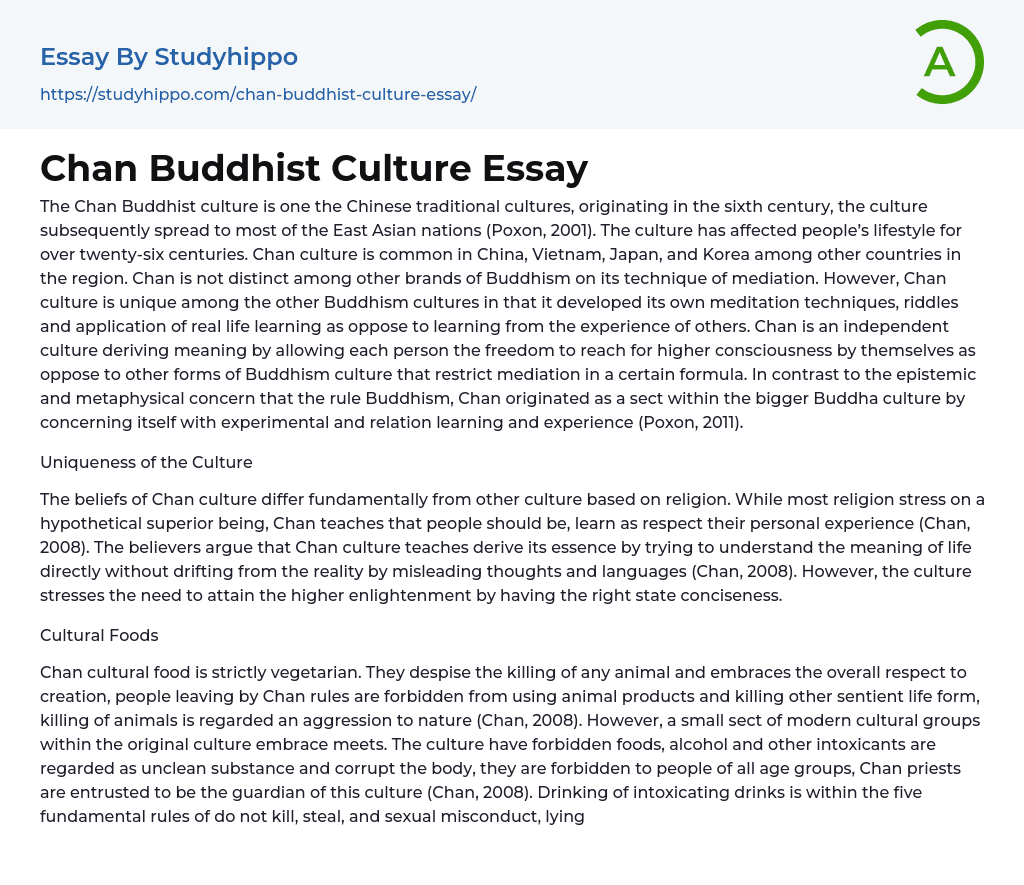The Chan Buddhist culture is one the Chinese traditional cultures, originating in the sixth century, the culture subsequently spread to most of the East Asian nations (Poxon, 2001). The culture has affected people’s lifestyle for over twenty-six centuries. Chan culture is common in China, Vietnam, Japan, and Korea among other countries in the region. Chan is not distinct among other brands of Buddhism on its technique of mediation. However, Chan culture is unique among the other Buddhism cultures in that it developed its own meditation techniques, riddles and application of real life learning as oppose to learning from the experience of others. Chan is an independent culture deriving meaning by allowing each person the freedom to reach for higher consciousness by themselves as oppose to other forms of Buddhism culture that restrict mediation in a certain formula. In contrast to the epistemic and metaphysi
...cal concern that the rule Buddhism, Chan originated as a sect within the bigger Buddha culture by concerning itself with experimental and relation learning and experience (Poxon, 2011).
Uniqueness of the Culture
The beliefs of Chan culture differ fundamentally from other culture based on religion. While most religion stress on a hypothetical superior being, Chan teaches that people should be, learn as respect their personal experience (Chan, 2008). The believers argue that Chan culture teaches derive its essence by trying to understand the meaning of life directly without drifting from the reality by misleading thoughts and languages (Chan, 2008). However, the culture stresses the need to attain the higher enlightenment by having the right state conciseness.
Cultural Foods
Chan cultural food is strictly vegetarian. They despise the killing of any animal and embraces the overall respect
to creation, people leaving by Chan rules are forbidden from using animal products and killing other sentient life form, killing of animals is regarded an aggression to nature (Chan, 2008). However, a small sect of modern cultural groups within the original culture embrace meets. The culture have forbidden foods, alcohol and other intoxicants are regarded as unclean substance and corrupt the body, they are forbidden to people of all age groups, Chan priests are entrusted to be the guardian of this culture (Chan, 2008). Drinking of intoxicating drinks is within the five fundamental rules of do not kill, steal, and sexual misconduct, lying and partaking of intoxicating drinks. Such drinks are seem to be clouding the mind making it impossible to achieve enlightenment (Chan, 2008).
Major Religion of the Culture
Chan people are strict Buddhists. Their conduct is guided by Buddhism believes. Their religious believes have relation to Hinduism and Jainism (Chan, 2008). While they were driven out of India, Chan culture is prospering in the surrounding countries with most of its people embracing more of traditional Buddha monk teachings. The culture does not have any distinct food for religious purposes; however, special herbal drinks made from fig tree are used in religious celebration as the only special food, symbolizing the acceptance of the special fig tree (Chan, 2008). Other foods of vegetable origins are also used in religious ceremonies but have no symbolic place
Health Beliefs
According to the Chan culture, health and diseases are inherent in human life, they see health to be dependent on a number of factors including the economic factors, social and morality and cultural perspectives (Kim, 2015). The distinctive aspect of the culture
regarding health is their beliefs on the existence of several life. They believe that people’s health is determined by their action from the previous lives and the current life they live. Families and relatives believe that people suffer for the sake of their loves ones. At old age, sickness and health are seen as a stage of life when they are ready to depart and begin a new stage of life through reincarnation (Kim, 2015).
Challenges, Problems in the US
While the US culture is based purely on capitalism and individual levels of interaction are guided by pop culture, the Chan culture follows strict Buddhism rule. There are elements of Confucianism in Chan method of learning, which focuses on social customs (li), and compassion (ren) as oppose to US education, which is guided by the need to generate new knowledge (Walters, 2003). Ren is the thoughtfulness, and is not any particular quality, but rather an ethical guide. The Chan culture focuses on the relationship between "two persons," which defines how to possibly live respectively without state laws while the US culture requires people to live by the law. The Ren has been the focus of Chan culture since its formation; it is the principle upon which its people and rulers achieve enlightenment and uniformity (Walters 2003). The different ethical views and reasoning from the two cultures will can pose serious problem when settled in the modern US.
Conclusion
Chan culture is one of the world’s known cultures. It Buddhism perspectives relates it to the traditional Chinese cultures. They are distinct in their choice of vegetarian diet and respect to nature. In resemblance to other cultures originating from the Buddhism,
Chan people believe in reincarnation and relate it to the current health situation of the people. The culture has significant differences with the US culture making its introduction to the country challenging.
References
- Chan, Y. (2008). Popular Buddhist Ritual in Contemporary Hong Kong: Shuilu Fahui, a Buddhist Rite for Saving All Sentient Beings of Water and Land. Buddhist Studies Review, 25(1).
- Kim, H. (2015). The Buddhist Ideology to Social Welfare. IAFBTAC, 25, 107-121.
- Poxon, J. (2001). Culture and Self: Philosophical and Religious Perspectives, East and West (review). Buddhist-Christian Studies, 21(1), 140-144.
- Walters, J. (2003). Buddhist Learning and Textual Practice in Eighteenth-Century Lankan Monastic Culture (review). Buddhist-Christian Studies, 23(1), 189-193.
- Wells, H. (2005). Transformation of Hearts and Minds: Chan Zen--Catholic Approaches to Precepts. Buddhist-Christian Studies, 25(1), 155-156.




